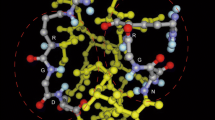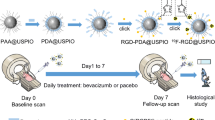Abstract
Integrin is often significantly upregulated in activated endothelial cells during tumor angiogenesis. The arginine-glycine-aspartic acid (RGD) peptide sequence is a specific recognition motif to αvβ3 integrin. In this study, a RGD labeled, Poly lactic acid (PLA) coated ultrasmall paramagnetic iron oxide (USPIO) (referred to as RGD-PLA-USPIO) were developed and the ability to detect tumor angiogenesis was investigated in vitro and in vivo. Increased uptake of RGD-PLA-USPIO by human umbilical vein endothelial cells (HUVECs) was detected by Prussian blue stain and transmission electronic microscopy (TEM). Pronounced signal decrease in T2*-weighted magnetic resonance image (MRI) and heterogeneous arrangement of neovasculature of tumor tissue were clearly identified in Vx-2 tumor model. The MR signal of contralateral muscle only could be seen a slight background change after either RGD-PLA-USPIO or PLA-USPIO injection. These studies demonstrate the efficiency of RGD-PLA-USPIO to visualize αvβ3 integrin in activated tumor endothelial cells and its potential for detecting and monitoring tumor vasculature change after therapy
Similar content being viewed by others
References
Fujita Y, Abe R, Shimizu H. Clinical approaches toward tumor angiogenesis: Past, present and future. Curr Pharm Des, 2008, 14: 3820–3834
Gupta M K, Qin R Y. Mechanism and its regulation of tumor-induced angiogenesis. World J Gastroenterol, 2003, 9: 1144–1155
Kobayashi H, Lin P C. Nanotechnology for antiangiogenic cancer therapy. Nanomed, 2006, 1: 17–22
Garmy-Susini B, Varner J A. Roles of integrins in tumor angiogenesis and lymphangiogenesis. Lymphat Res Biol, 2008, 6: 155–163
Serini G, Valdembri D, Bussolino F. Integrins and angiogenesis: A sticky business. Exp Cell Res, 2006, 312: 651–658
Yoshimoto M, Ogawa K, Washiyama K, et al. alpha(v)beta(3) Integrin-targeting radionuclide therapy and imaging with monomeric RGD peptide. Int J Cancer, 2008, 123: 709–715
Strieth S, Eichhorn M E, Sutter A, et al. Antiangiogenic combination tumor therapy blocking alpha(v)-integrins and VEGF-receptor-2 increases therapeutic effects in vivo. Int J Cancer, 2006, 119: 423–431
Suh D Y. Understanding angiogenesis and its clinical applications. Ann Clin Lab Sci, 2000, 30: 227–238
Schottelius M, Laufer B, Kessler H, et al. Ligands for mapping alphavbeta3-integrin expression in vivo. Acc Chem Res, 2009, 42: 969–980
Xiao Y, Truskey G A. Effect of receptor-ligand affinity on the strength of endothelial cell adhesion. Biophys J, 1996, 71: 2869–2884
Wang W, Wu Q, Pasuelo M, et al. Probing for integrin alphav beta3 binding of RGD peptides using fluorescence polarization. Bioconjug Chem, 2005, 16: 729–734
Liu S. Radiolabeled multimeric cyclic RGD peptides as integrin alphavbeta3 targeted radiotracers for tumor imaging. Mol Pharm, 2006, 3: 472–487
Jaffer F A, Libby P, Weissleder R. Optical and multimodality molecular imaging: Insights into atherosclerosis. Arterioscler Thromb Vasc Biol, 2009, 29: 1017–1024
Weissleder R, Pittet M J. Imaging in the era of molecular oncology. Nature, 2008, 452: 580–589
Sosnovik D E, Weissleder R. Emerging concepts in molecular MRI. Curr Opin Biotechnol, 2007, 18: 4–10
Sosnovik D E, Nahrendorf M, Weissleder R. Molecular magnetic resonance imaging in cardiovascular medicine. Circulation, 2007, 115: 2076–2086
Chapon C, Franconi F, Lacoeuille F, et al. Imaging E-selectin expression following traumatic brain injury in the rat using a targeted USPIO contrast agent. MAGMA, 2009, 22: 167–174
Burtea C, Laurent S, Vander Elst L, et al. Contrast agents: Magnetic resonance. Handb Exp Pharmacol, 2008, 185: 135–165
Liu S, Wei X, Chu M, et al. Synthesis and characterization of iron oxide/polymer composite nanoparticles with pendent functional groups. Colloids Surf B Biointerfaces, 2006, 51: 101–106
Bratosin D, Mitrofan L, Palii C, et al. Novel fluorescence assay using calcein-AM for the determination of human erythrocyte viability and aging. Cytometry A, 2005, 66: 78–84
Herschman H R. Molecular imaging: Looking at problems, seeing solutions. Science, 2003, 302: 605–608
Massoud T F, Gambhir S S. Molecular imaging in living subjects: Seeing fundamental biological processes in a new light. Genes Dev, 2003, 17: 545–580
McCarthy J R, Weissleder R. Multifunctional magnetic nanoparticles for targeted imaging and therapy. Adv Drug Deliv Rev, 2008, 60: 1241–1251
Rehman S, Jayson G C. Molecular imaging of antiangiogenic agents. Oncologist, 2005, 10: 92–103
Haubner R, Gratias R, Diefenbach B, et al. Structural and functional aspects of RGD-containing cyclic pentapeptides as highly potent and selective integrin αvβ3 antagonists. J Am Chem Soc, 1996, 118: 7461–7472
Sipkins D A, Cheresh D A, Kazemi M R, et al. Detection of tumor angiogenesis in vivo by αvβ3-targeted magnetic resonance imaging. Nat Med, 1998, 4: 623–636
Winter P M, Caruthers S D, Kassner A, et al. Molecular imaging of angiogenesis in nascent Vx-2 rabbit tumors using a novel αvβ3-targeted nanoparticle and 1.5 Tesla magnetic resonance imaging. Cancer Res, 2003, 63: 5838–5843
Schmieder A H, Winter P M, Caruthers S D, et al. Molecular MR imaging of melanoma angiogenesis with αvβ3-targeted paramagnetic nanoparticles. Magn Reson Med, 2005, 53: 621–627
Mulder W J, Strijkers G J, Habets J W, et al. MR molecular imaging and fluorescence microscopy for identification of activated tumor endothelium using a bimodal lipidic nanoparticle. FASEB J, 2005, 19: 2008–2010
Bulte J W, Kraitchman D L. Iron oxide MR contrast agents for molecular and cellular imaging. NMR Biomed, 2004, 17: 484–499
Tsushima Y, Endo K. Hypointensities in the brain on T2*-weighted gradient-echo magnetic resonance imaging. Curr Probl Diagn Radiol, 2006, 35: 140–150
Thamburaj K, Radhakrishnan V V, Thomas B, et al. Intratumoral microhemorrhages on T2*-weighted gradient-echo imaging helps differentiate vestibular schwannoma from meningioma. AJNR Am J Neuroradiol, 2008, 29: 552–557
Tosaka M, Sato N, Hirato J, et al. Assessment of hemorrhage in pituitary macroadenoma by T2*-weighted gradient-echo MR imaging. AJNR Am J Neuroradiol, 2007, 28: 2023–2029
Zhang C, Jugold M, Woenne E C, et al. Specific targeting of tumor angiogenesis by RGD-conjugated ultrasmall superparamagnetic iron oxide particles using a clinical 1.5-T magnetic resonance scanner. Cancer Res, 2007, 67: 1555–1562
Maehara N. Experimental microcomputed tomography study of the 3D microangio architecture of tumors. Eur Radiol, 2003, 13: 1559–1565
Jiang H J, Zhang Z R, Shen B Z, et al. Quantification of angiogenesis by CT perfusion imaging in liver tumor of rabbit. Hepatobiliary Pancreat Dis Int, 2009, 8: 168–173
Lee K H, Liapi E, Buijs M, et al. Considerations for implantation site of Vx-2 carcinoma into rabbit liver. J Vasc Interv Radiol, 2009, 20: 113–117
Author information
Authors and Affiliations
Corresponding author
About this article
Cite this article
Wu, X., Zhang, J., Lin, B. et al. Molecular imaging of tumor angiogenesis using RGD-labeled iron oxide nanoparticles. Chin. Sci. Bull. 55, 2662–2670 (2010). https://doi.org/10.1007/s11434-010-4004-8
Received:
Accepted:
Published:
Issue Date:
DOI: https://doi.org/10.1007/s11434-010-4004-8




